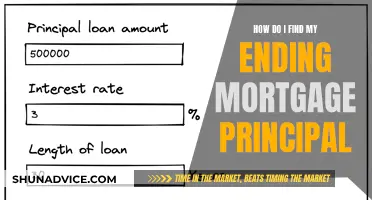
Holding a mortgage is a non-traditional way to finance a home when a buyer is unable to qualify for a traditional mortgage. In this scenario, the home seller acts as the lender and retains the property title, with the buyer paying them directly each month. This type of agreement is typically outlined in a promissory note between the buyer and seller, specifying conditions such as interest rates, repayment periods, and down payments. While holding mortgages offer certain advantages, such as lower monthly payments and increased negotiation opportunities, they also come with potential drawbacks, including higher interest rates and the possibility of a large balloon payment at the end of the term.
Characteristics and Values of Holding a Mortgage
| Characteristics | Values |
|---|---|
| Type of agreement | A promissory note between the buyer and seller outlines the terms, including interest rate, repayment period, and down payment. |
| Lump-sum payment | Depending on state laws, a large balloon payment may be required at the end of the repayment term. |
| Costs | The contract may outline how costs like property taxes and insurance are paid. With a holding mortgage, the buyer may pay these directly to the government and insurance company. |
| Interest rate | The interest rate is typically higher than traditional mortgages, but buyers may negotiate lower rates. |
| Seller's role | The seller acts as the lender and retains the property title. |
| Buyer's payments | Buyers make monthly payments directly to the seller, which may include principal and interest. |
| Seller's income | The seller receives passive income with a potentially higher interest rate than other investments. |
| Loan terms | The seller decides the loan terms, including interest rate, repayment period, and down payment. |
| Tax burden | Holding a mortgage can reduce the seller's tax burden by spreading out income over time. |
| Default risk | If the buyer defaults, the seller can take back the property and keep any payments made, but initiating foreclosure takes time and money. |
| Buyer qualification | Holding mortgages are an option for buyers who don't qualify for traditional mortgages, and sellers may request financial information to qualify buyers. |
| Down payment | Sellers may require a larger down payment to incentivize timely payments and avoid foreclosure. |
| Legal advice | Buyers and sellers should consult a real estate attorney before entering an agreement, and an attorney should write up the promissory note. |
| Length of agreement | Holding mortgages are typically short-term, ranging from five to ten years, compared to 30 years for traditional mortgages. |
What You'll Learn

The seller acts as the lender
In a holding mortgage, the seller acts as the lender and retains the property title. The buyer makes monthly payments directly to the seller. This is a viable option for those who don't qualify for traditional mortgages.
Holding mortgages are a form of non-conforming loan that involves owner financing. The homeowner acts as a lender to the home buyer, offering them a loan to finance their purchase. The buyer makes monthly payments to the seller, who retains the property title until the loan has been paid in full.
The details of a holding mortgage agreement are typically outlined in a promissory note between the buyer and seller. This includes conditions of the loan such as the interest rate, repayment period, and down payment. The promissory note is a legally binding document that outlines the terms of the loan, including the interest rate, repayment schedule, and any penalties for late payments. It is important to consult with a real estate attorney before entering into a holding mortgage agreement to ensure that all legal requirements are met.
Holding mortgages usually have a higher interest rate than traditional mortgages, which can increase the overall cost for buyers. They also come with additional liability for the seller, who may have to initiate foreclosure or assume responsibility for the state of the property if the buyer defaults on their payments.
One of the benefits of a holding mortgage for sellers is the potential for higher interest returns. Sellers can receive interest on the loan they offer, which can result in a higher return than other investment options. Sellers also have full control over the deal, including deciding on the loan terms, which gives them more control over the sale. Additionally, holding mortgages can help sellers attract a wider pool of buyers and speed up the selling process by eliminating mortgage and lender delays.
Finding Your Mortgage Account Number: A Simple Guide
You may want to see also

Pros and cons for sellers
Holding a mortgage as a seller can be an attractive option if you are looking to sell quickly, as it provides more flexibility than traditional mortgage options. It can also help attract a wider pool of buyers, including those who may not qualify for a traditional mortgage.
One of the main benefits of holding a mortgage is that it provides a monthly passive income in the form of interest payments. Sellers can set the terms for the mortgage, including the interest rate, repayment period, and down payment, giving them more control over the sale. Holding a mortgage can also result in potential savings on fees, such as real estate agent commissions. Additionally, if the buyer defaults on the loan, the seller can take back the property and keep any payments made, protecting them from financial loss.
However, there are also several drawbacks to consider. Acting as the lender comes with certain risks, and if the buyer stops making payments, the seller must enter legal proceedings to foreclose on the property. This can be a time-consuming and costly process, and there is also a risk of significant damage to the property due to neglect. Furthermore, buyers may have a harder time finding a lender to refinance their holding mortgage, and there may be concerns about the seller's financial stability if they hold the title.
Overall, while holding a mortgage as a seller can provide benefits such as passive income and more control over the sale, it is important to carefully weigh these against the potential drawbacks, including the additional responsibilities and risks associated with lending.
Finding Your Mortgage Number: A Simple Guide to Locating It
You may want to see also

Pros and cons for buyers
A holding mortgage is a non-conforming loan that involves owner financing. The homeowner acts as the lender, offering a loan to the buyer to finance their purchase. The buyer makes monthly payments to the seller, retaining the property title until the loan has been paid in full.
Pros for Buyers:
Holding mortgages offer an alternative option for buyers who may not qualify for traditional types of home loans. The conditions can be tailored to meet the specific needs of the buyer and seller, and buyers may have a greater opportunity to negotiate lower interest rates and down payments.
- Lenient terms: Buyers may have more lenient qualification requirements, such as credit scores, than with a conventional mortgage.
- More opportunities to negotiate: Buyers may be able to negotiate lower interest rates and down payments.
- Shorter loan term: Holding mortgages typically have a shorter term than traditional mortgages, allowing buyers to pay off their debt faster.
- No upfront amount: Buyers may avoid the need for a large, upfront payment, such as a down payment or closing costs.
- Faster closing: Buyers can avoid the hassle and time required to get a bank-issued mortgage and close on their new home faster.
Cons for Buyers:
Holding mortgages may come with higher interest rates than traditional mortgages, and there may be risks involved if proper legal proceedings are not followed.
- Higher interest rates: Holding mortgages may have higher interest rates than traditional mortgages.
- Can be risky: Holding mortgages aren't usually regulated by the same consumer protection laws, so buyers may have fewer consumer protections.
- Seller bankruptcy: If the seller experiences financial difficulties or bankruptcy, this could risk the buyer's investment.
- Difficulty refinancing: Buyers may have trouble finding a lender to refinance their holding mortgage.
FHA Mortgage Problems: Quick and Easy Solutions
You may want to see also

The legal process
Holding a mortgage involves the transfer of interest in land as security for a loan or other obligation. The mortgagor (the party transferring the interest in land) and the mortgagee (usually a financial institution) are the two parties involved in this process. The mortgagee provides the loan or other interest in exchange for the security interest. The law of mortgages is mainly governed by state statutory and common law, and mortgages are regulated by federal or state agencies.
The mortgage process involves six steps: pre-approval from mortgage lenders, house shopping, mortgage application, loan processing, underwriting, and closing. Before shopping for a house, you need to secure pre-approval from a mortgage lender. This shows sellers that you're a serious buyer and helps you narrow down your options. You can apply for a mortgage after choosing a property or while still shopping for one. Being pre-approved can give buyers an advantage in a competitive housing market.
Once you've found a property and made an offer, the mortgage closing process begins. This typically takes 30 to 60 days to complete. During this process, the buyer and seller agree on the terms of the deal, including the interest rate, repayment period, and down payment. The buyer will then make their down payment to the lender, and the seller will transfer ownership of the property to the buyer and receive the agreed-upon sum. The buyer will sign any remaining mortgage documents, and the lender may charge fees for originating the loan.
It is important to carefully review all paperwork and seek clarification for any unclear terms or conditions. Certain changes, such as discrepancies in the APR, the addition of prepayment penalties, or changes to the loan product, can cause the mortgage agreement to be put on hold. If everything is in order, the mortgage will automatically go live after three days. The mortgage contract typically allows for a final walk-through of the property at least 24 hours before closing.
Understanding Your Mortgage: Finding the Principal Balance
You may want to see also

Alternatives to holding a mortgage
Holding a mortgage is a non-traditional financing option where the home seller acts as the lender to the buyer. The details of the agreement are typically outlined in a promissory note, including conditions such as interest rates, repayment periods, and down payments.
Traditional Mortgage:
The most common alternative is a traditional mortgage from a bank or financial institution. This option may offer lower interest rates and more favourable terms compared to a holding mortgage. It is a more conventional route to financing a home purchase.
Seller-Financed Mortgage:
In this arrangement, the home seller acts as the bank and holds the mortgage while the buyer makes payments directly to them. The terms of the agreement are often negotiable, including interest rates and repayment schedules. This option can be beneficial for buyers who may face challenges securing a traditional mortgage due to credit issues or unconventional financial circumstances.
Alternative Loans:
There are alternative loan options available with lower down payment requirements, such as VA loans, FHA loans, or USDA loans. These loans may be more accessible to buyers who lack substantial savings but still want to purchase a home. However, it is important to proceed with caution and understand the potential risks associated with non-traditional loans.
Borrowing from Retirement Accounts:
If you have sufficient funds in your 401(k) or IRA, you can consider borrowing from these accounts to finance a home purchase. However, there are potential drawbacks, including penalties and taxes on withdrawals, and the negative impact on your retirement prospects. Financial advisors generally do not recommend this option unless there are extenuating circumstances.
Family Mortgages and Life Insurance Policies:
Some companies specialise in facilitating home loans between family members. Additionally, many life insurance policies allow policyholders to take out loans against the principal amount. While these options may provide flexible borrowing opportunities, it is important to consider the potential impact on inheritance and estate planning.
Private Lenders and Digital Mortgage Platforms:
Private lenders, such as Kiavi, offer an alternative to traditional mortgages by providing real estate loans to investors. Digital mortgage platforms, like Simplist and Tomo Mortgage, specialise in streamlining the mortgage application process and improving the homebuying experience through technology. These alternatives can provide faster and more customised options for homebuyers.
Finding Assumable Mortgages: Strategies for Success
You may want to see also
Frequently asked questions
A holding mortgage is a non-traditional way of financing a home purchase where the home seller acts as the lender and retains the property title. The buyer pays the seller directly each month.
Holding mortgages can be beneficial for buyers who don't qualify for traditional mortgages, allowing them to secure a home with more lenient terms and conditions. They also provide an opportunity for sellers to earn additional income and attract a wider pool of buyers.
Holding mortgages typically have higher interest rates than traditional mortgages, which can increase the overall cost for buyers. They may also involve a large balloon payment at the end of the repayment term. For sellers, holding a mortgage limits their ability to invest in other opportunities and comes with additional liability if the buyer defaults on payments.
To obtain a holding mortgage, buyers should consult with a real estate attorney to understand the legal implications and ensure compliance with seller financing laws. Sellers should also qualify buyers by requesting their financial information to assess their ability to repay the loan.
Holding mortgages offer flexibility and alternative options for both buyers and sellers, but they also come with risks. It's important to carefully research and understand the potential downsides, such as higher interest rates, limited consumer protections, and the possibility of a large balloon payment. For sellers, there is the added risk of buyer default and the impact on their ability to invest elsewhere.







